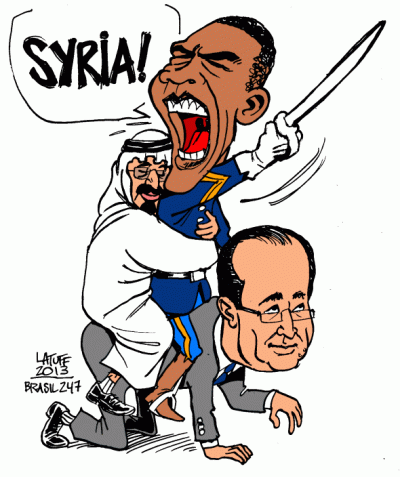Paris 11/13: The Strategy of Chaos
The Art of War

Flags fly at half-mast in NATO countries for “France’s 9/11,” while President Obama announces to the media: “We will provide you accurate information about who is responsible.” They needn’t wait. It is already clear. The umpteenth massacre of innocents was caused by the series of geopolitical cluster bombs, detonated according to a precise strategy.
It has been put into play since the U.S. won the confrontation with the Soviet Union and appointed itself “the only state with truly global strength, reach and influence in every dimension — political, economic and military” proposing to “deter those powers that might seek regional dominance – Western Europe, East Asia, the former Soviet Union and Southwest Asia – whose resources would be sufficient to generate global power.”
To this end the U.S. has refocused its strategy since 1991 and, in agreement with the European powers, that of NATO. Since then they have disintegrated or demolished by war (open and covert), one after another, the states considered an obstacle to the plan of global domination; these include Iraq, Yugoslavia, Afghanistan, Libya, Syria, Ukraine and others – while still others (including Iran) are being targeted.
These wars, which have claimed millions of victims, have disrupted whole societies, creating a huge mass of desperate people, whose frustration and rebellion lead on the one hand to a real resistance, but on the other hand are being exploited by the CIA and other intelligence services (including French ones) to ensnare fighters in a “jihad,” which in fact suits the strategy of U.S./NATO. This led to the formation of a shadow army, made up of (often competing) Islamic groups used to undermine the Libyan state from within while NATO attacked it, and then for a similar operation in Syria and Iraq.
From all this ISIS was born, in which “foreign fighters” came together with agents of the secret services, and which has received billions of dollars and modern weapons from Saudi Arabia and other Arab monarchies, allied with the U.S. and particularly with France.
This strategy is nothing new: some 35 years ago, to bring down the Soviet Union in the “Afghan trap,” tens of thousands of mujahadin were recruited by the CIA from over 40 countries. Among them was the rich Saudi citizen named Osama bin Laden, who arrived in Afghanistan with 4,000 men, the same person who after he founded Al Qaeda turned into “enemy number one” of the United States.
Washington is no sorcerer’s apprentice, unable to control the forces it set in motion. It is the driving force of a strategy that destroys entire states, causing a chaotic chain reaction of division and conflict to be used according to the old method of “divide and rule.”
The terrorist attack in Paris, performed by an unskilled laborer convinced to strike a blow against the hated West, occurred with perfect timing just as Russia, intervening militarily, had blocked the U.S./ NATO plan to destroy the Syrian state and announced military countermeasures to the growing expansion of NATO to the East.
The terrorist attack, by creating a climate of siege in Europe, “justifies” an accelerated military buildup of the NATO European countries, which includes increasing their defense spending as requested by the U.S., and opens the way for other wars under U.S. command. France, which so far “had been bombing inside Syria only sparingly” against Isis, as the New York Times writes, “bombed the Syrian city of Raqqa on Sunday night [Nov. 15], its most aggressive strike against the Islamic State group” hitting targets described by the United States. Among these, U.S. officials specify, are “some clinics and a museum.”
Translation : John Catalinotto

